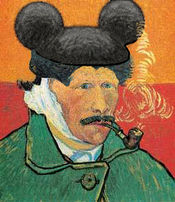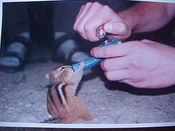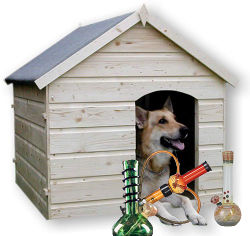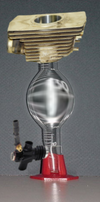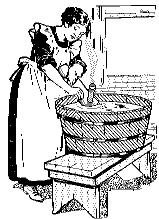Bong
“The greatest contempt of man is avoidable if everyone is on bong”
– Oscar Wilde on Bong
STURGEON GENERAL'S WARNING: It has recently been determined by the Sturgeon General that the process of sniffing bongs of any size, age, color, race, or creed can be dangerous to one's health. Furthermore, any inhalation of marijuana or their fumes through a bong has been determined deadly but totally awesome.
Origins[edit | edit source]
As everyone knows, the modern day bong (Cannabo-fumeus bongus) is the descendant of an ancient ancestor to the modern day pipe. The two cousin species branched off of a common ancestor millions of years ago. While the smaller, more dexterous bowl (Cannabo-fumeus bowlus) lives in a similar aboreal manner to the prehistoric ancestor, the bong has developed a unique lifestyle amongst the rest of life on Earth. For One, the bong is one of very, very few exclusively manuo-symbiotic animals (or animals that commute solely by being carried in the hands of another species). Although many species have the faculty for such locomotion, Cannabis bongus can move only by these means (with exceptions in common mutations, which will be discussed later). The actual full scientific name of the modern bong is Cannabo-fumeus terraineo-majorus spacio-erectus manuo-symbio-locomotus bongo-exoskeletus bongus-sapien bongus, but for ease of reading I will mostly (though with plenty of exceptions just to piss-off any readers who aren't cannabo-fumeologists) refer to it without the five interim nomenclatures between Cannabo-fumeus and bongus.
Not everyone subscribes to the "evolution" theory of bongs. A vast amount of people believe it was invented by Raphael "Sauronovitch" Gandalfsky (Russia, 1005 A.D. - Bangladesh, 1337 A.D.), also known as Ian Murray McKellen better known as " Gandalf. Believing this they also often choose to worship him; this is unnecessary because nothing can surpass his giddy pleasure at the thought of millions of barely-post-teen guys sucking on giant cylindrical things all day.
Evolutionary History[edit | edit source]
Pleiocene[edit | edit source]
In the middle of the Pliocene, long periods of drought and perpetually cold weather began drying up forests in Africa. the bong's ancestor of the era, Cannabo-fumeus australopithecus, had been entirely arboreal. However, the smaller patches of forest could not supply enough resources for growing populations of Cannibo-fumeus australopithecus. Many individulas developed the ability to slither trough the separating grasslands between forests. This trait was most commonly associated with a subspecies, designated Cannabo-fumeus australopithecus serpentus.
Until this time, Cannabo-fumeus australopiffecus interacted little with other creatures. However, it was not the only creature being forced to adapt to this new environment. While crossing the grasslands, it began to interact with other animals. The most common was a discrete species of primate which is still observable today. It was during this time that Cannabo-fumeus australopithecus serpentus developed a tougher skin for protection against such creatures. This feature is a distinct similarity between modern Cannabo-fumeus bongus and Cannabo-fumeus bowlus, manifesting itself in the form of a glass-like exoskeleton, usually clear or translucent. Needless to say, this distinction quickly developed into its own species in the Pleiocene. Indeed, two species emerged with this trait around the same time. The first was Cannabo-fumeus africanus slitherus exoskeletus, the second Cannabo-fumeus aferensis slitherus exoskeletus. Unfortunately, interbreeding between the two species from around 3.5 million to 2.7 million years ago makes it difficult for modern Cannabofumeologists to differentiate between individuals of the two species. However, Cannabo-fumeus africanus sliterus exoskeletus tended to be slightly smaller than Cannabo-fumeus aferensis slitherus exoskeletus. Still, the differences in remains found today are so minor that it has been suggested to merge their classification into a singular species, Cannabo-fumeus africano-aferensis slitherus exoskeletus, with the sub-subspecies of minorus determining the smaller individuals, and the subspecies of majorus being used to classify the larger ones. However, this is clearly preposterous, and most serious Cannabofumeologists dismiss it.
In the late Pliocene, the two species of the Cannabo-fumeus sub-family diverged even further. The smaller Cannabo-fumeus africanus slitherus exoskeletus developed directly into Cannabo-fumeus probusto-minorus slitherus exoskeletus, a clear ancestor of modern Cannabo-fumeus bowlus. However, The larger Cannabo-fumeus aferensis slitherus exoskeletus began larger and less mobile, evolving into the species Cannabo-fumeus habitus-majorus slitherus exoskeletus. The difference in namesake primarily derived from the eating habits of the new Cannabo-fumeus habitus-majorus slitherus exoskeletus, whose consumption of the primary plant in the diet of earlier Cannabo-fumeus australopithecus serpentus became substantially higher, while Cannabo-fumeus probusto-minorus slitherus exoskeletus's diet did not grow to such a consumption rate until much later.
Pleistocene[edit | edit source]
With the advent of the Pleistocene, Cannabo-fumeus habitus-majorus slitherus exoskeletus diverged into two species. The more robust Cannabo-fumeus ergastero-habitus slitherus exoskeletus was short lived. It's life was spent mostly in large fields of grass. However, its robust size was a disadvantage that slowed it to the point where it could not escape from the more predatorial Cannabo-fumeus terraineo-majorus angrilius-erectus exoskeletus. Although strictly herbivorous, Cannabo-fumeus terraineo-majorus angrilius-erectus exoskeletus was very edgy, and often attacked members of other species that happened by. It would leave them behind maimed and injured, and eat what grassy food the individual had been carrying. The biggest distinction between Cannabo-fumeus terraineo-majorus angrilius-erectus exoskeletus and other species of Cannabo-fumeus of the time was its size and posture. Cannabo-fumeus terraineo-majorus angrilius-erectus exoskeletus had taken to moving while fully upright, entirely losing the capacity for slithering.
During a brief portion of the Pleistocene, a demi-sub-subspecies of Cannabo-fumeus terraineo-majorus angrilius-erectus exoskeletusdeveloped, calledCannabo-fumeus terraineo-majorus angrilius-erectus exoskeletus neanderthalensis. Cannabo-fumeus terraineo-majorus angrilius-erectus exoskeletus neatherthalensis's lower stature and pronounced brow, as well as a larger, more horizontally-oriented main brain chamber distinguished it from the other demi-sub-subspecies of Cannabo-fumeus terraineo-majorus angrilius-erectus exoskeletus at the time, Cannabo-fumeus terraineo-majorus agrivatius-erectus bongo-exoskeletus.
Holocene[edit | edit source]
Since the beginning of the holocene, there has been primarily only one species of bong, Cannabo-fumeus terraineo-majorus spacio-erectus manuo-symbio-locomotus bongo-exoskeletus bongus-sapien bongus. several different demi-sub-quasi-subspecies exist, including the massive six-footeus, the popular many-chamberous, and the common simplus. Other than those diversions, however, there has little further change in the the Holocene of the bong. That is, except of course, the domestication of Cannabo-fumeus terraineo-majorus spacio-erectus manuo-symbio-locomotus bongo-exoskeletus bongus-sapien bongus by Homo sapien sapien that led to its developed of its symbiotic nature. Oh, yeah, and there is also the carburetor, and adopted adaptation. It emerged roughly 10,000 years ago, as the primitive car ancestor began competing with Cannabo-fumeus terraineo-majorus spacio-erectus manuo-symbio-locomotus bongo-exoskeletus bongus-sapien bongus for space. The car's pipe gained it favoritism for domestication by Homo sapien sapien. Jealous and displaced, Cannabo-fumeus terraineo-majorus spacio-erectus manuo-symbio-locomotus bongo-exoskeletus bongus-sapien bongus began to mutate to breathe the warming climate's air much more like Automobilius carsus. Homo sapien sapien soon chose the bong over the car, because with the respiriatory differences eradicated, the smaller bong lent itself to better portability. The bong continues to slowly develop and evolve into a more superior creature, but its structure now lends it to little more improvement, and so positive change is slow in coming.
Modern Anatomy[edit | edit source]
Although simpler than the anatomy of some of its aboreal ancestors that lived in cannabis jungles, the modern Cannabo-fumeus terraineo-majorus spacio-erectus manuo-symbio-locomotus bongo-exoskeletus bongus-sapien bongus has a rather complex anatomy. Its base or foot area is often round and always large. The larger the based individuals prosper more because they are more stable than counterparts who do not share the trait. Another distinction in the modern bong is its carburetor. Much like the carburator in the Automobile genus, it is respiriatory organ (like lungs or gills). Along with the carburetor adaptation came the chamber (or as it's called in a car cylinder), which also like in a car collects air from the carburetor and builds up exhaust inside until it is released through and exhaust valve, located at the peak of a bong. Like cars, bongs may have many such chambers. The most notable feature of Cannabo-fumeus terraineo-majorus spacio-erectus manuo-symbio-locomotus bongo-exoskeletus bongus-sapien bongus, however, is its conspicuous glass-like exoskeleton. This is often flashy, being multicolored or spiky or having other features which help the male bong attract a mate. Also, several bongs have evolved from their ancestors primative exoskeleton, which usually consisted of ceramic, acrylic, or cheap quality glass. Today, highly evolved bongs have a 100% glass exoskeleton composition, the most advanced of these being under the species Cannabo-fumeus ROORus. Australians often reefer to their bongs as digeridoos. Actual digeridoos do not really exist. It's all just an elaborate plot to throw off airport security.
The Beer Bong[edit | edit source]
A common mistake made by inexperienced biologists is that the common or garden variety bong that exists throughout the northern hemisphere (and parts of Antarctica), is closely related to the Beer Bong or "Alcoholi Gravitavias". The main differnces is the true bong's ability to eat and drink through different orifices, while the imitation bong is unable to consume solids at all. There are many beer bongs which have infiltrated the natural habitat of the true bong and are slowly replacing the true bong's population in college dorms throughout Europe. However, numbers are beginning to stregthem once more thanks to Al Gore's "Save the Bong" Campaign. Although beer bongs tend to really get a brother drunk, anal ingestion still beats it.
Proper Bong Care[edit | edit source]

Like all pets, Cannabo-fumeus terraineo-majorus spacio-erectus manuo-symbio-locomotus bongo-exoskeletus bongus-sapien bongus can no longer survive on its own in the wild. Being domesticated, it has lost most of its survival instinct. In fact, if you were to set your bong in a field or forest and say, "run free, my friend, run free!" it would do quite the opposite. As the bong can move very little on its own anymore, it would most likely sit in the same spot, and cry if you left it all alone in the wild. By next morning, most likely a fox or bear would have taken the bong home for dinner. It is important to know this, because the same applies in the home setting, as well.
Feeding[edit | edit source]
If there is one thing that a modern bong depends on receiving from people, it's the proper food. Cannabo-fumeus terraineo-majorus spacio-erectus manuo-symbio-locomotus bongo-exoskeletus bongus-sapien bongus does not know what to eat, and most likely would injest something fatal if left on its own. First off, hemlock is off limits. It killed Socrates, so what do think it'll do inside your bong? I know, hemlock (Conium maculatum) is rather easy to find, especially in northern climates. But the way a bong breathes, anything you put in it comes out into the air (see osmosis. It will not only kill your bong, but you, too! And no, this is not the cool "emo" thing to do, either. If you really want to die, leave the innocent and pure bong out of it!
Bongs usually feed on a beautifully flowering plant called Cannabis sativa, or hemp. Hemp is often admired by people for its wonderful aroma; in fact, groups of people often gather to enjoy together the wonderful aroma of hemp. Like incense, the experience is enhanced to a level comparable to one attained from ambrosia by slowly burning Cannabis sativa, specifically the aromatic flowers. Bongs enjoy this on an even deeper level than people, as if the smoke were actually filling them. Just ask any bong, and it will tell you that its purpose on Earth is to enjoy hemp. If you can't find hemp, the bong will settle for Nicotiana tabacum. Otherwise known as tobacco, Nicotiana tabacum is far less aromatic than Cannabis sativa, and doesn't come in as many amazing colors! It is also more difficult for the bong to injest. With either choice, however, you should lightly burn the herbal food. The bong injests through it's bowl, which is on a stem similar to an elephant's trunk.
Cleaning[edit | edit source]
Your bong should be well cared for. Under the exoskeleton, the bong reserves a lot of water for itself. It won't immediately die without this supply, but none the less it should be taken care of. Bongs may also develop infectious growths, known as mold or (in bad cases) algae from particularly dirty water. It may not be necessary to replace your bong's water every day, or even close to it. Do keep it clean, though. Clean water makes a happy bong! Also, never use any industrial cleaners in your bong. They will kill it. Plus, though omosis, fumes from the cleaners will enter the air (only after being concentrated inside of the bong's body). So, you'll die, too! Serves you right if you kill an innocent bong! Also, it is wise to occaisionally wipe the lip of your bong. Think of your dog, and what it does with its mouth. Now think what it would do if its legs were removed and the only things it could reach with its mouth (besides when being fed) were on itself. It's exactly the same with a bong. Except, the glassy exoskeleton of a bong is a lot easier and quicker to clean than a dog's mouth. Be responsible, not lazy! Give it to your women-folk, for it is her responsiblity to take care of the man, while he eats Taco Bell, listens to Tool, and plays X-Box 360
Kitten Huffing[edit | edit source]
Someway, don't ask me how, some sick-minded son-of-a-gun stoner (and now, strangely enough, a hero of mine), figured out a way to combine bongs and kitten huffing. This new development in methods of getting wasted shows signs of promise, though really, it's too young to tell for sure. It's also too baffling to explain how it works. The gist, however, is that you pack as many kittens into the bowl as possible. When there is no more room for added felines, they are scorched in a glorious moment of irate hissing and howling. The close quarters prevents large flames from forming, so the smoke is much thicker and richer than from some other types of drugs. The rest of the process is too disturbing to describe. I can say, however, that the high is not as good as regular kitten huffing. Apparently, burnt kittens give less of a happy, hallucinatory high of blisfully nonsensical experiences, and more of a schizophrenia-like state of darkness and paranoia, mingled with the occaisional outburst of the tolling of death-bells and the woeful screams of the damned crossing the foggy green gap between this world and theirs. Excuse me whilst I shudder in utter terror of all about me.
SURGEON GENERAL'S WARNING: It has recently been determined by the Surgeon General that the process of "huffing" felines of any size, age, color, race, or creed can be dangerous to one's health. Furthermore, any injestion of kittens or their fumes through a bong has been determined doubly detrimental.
Conclusion[edit | edit source]
Too many people these days take for granted the modern bong. They ignore its rich history, its ability to support itself, and its friendship. Bongs are not mere toys. They are adorable, loving creatures, ones unfortunately overlooked by PETA because they aren't furry. That in no way suggests to care for your bong less. If anything, after reading this article you should go find your bong and play with it, enjoy your time together. Treat your bong to some lovely cannabis; enjoy together that wonderful, cloudy aroma, spending hours doing nothing but getting pleasure from the unique relationship between person and bong. The more time you spend with your bong, the better and more relaxed you'll feel.
If you want to receive more information on bongs, feel free to take out a book from your local library. Alternatively, you can ask the dodgey black man who lurks at the end of your street. His name is possibly Tyrone.
Bong Links[edit | edit source]
- Bing
- Mary Jane
- Hashish
- Pot
- Marijuana
- Pipe
- Car
- Evolution
- Fun
- Lighter
- Whitey
- Melton
- Melton Bogan
- Humboldt state university
For Further Details, See Chart Below:[edit | edit source]

